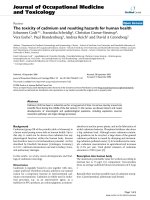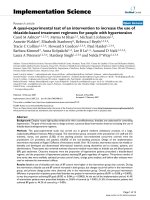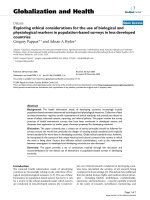The use of tympanometry and pneumatic otoscopy for predicting middle ear disease KHÁ có PHẦN kết LUẬN được
Bạn đang xem bản rút gọn của tài liệu. Xem và tải ngay bản đầy đủ của tài liệu tại đây (62.63 KB, 1 trang )
/>American Journal of Audiology Vol.14 3-13 June 2005. doi:10.1044/1059-0889(2005/002)
© American Speech-Language-Hearing Association
The Use of Tympanometry and Pneumatic Otoscopy for
Predicting Middle Ear Disease
Paula K. Harris 1, Kathleen M. Hutchinson 2, and Joseph Moravec 3
1
Midwest Ear, Nose and Throat Clinic, Herrin, IL
Miami University, Oxford, OH
3
Joseph J. Moravec, Inc., Facial Surgery Center, Cincinnati, OH
2
Purpose: Otitis media is the most common condition diagnosed by pediatricians and is estimated
to affect approximately 70% of the pediatric population. The goal of this study was to evaluate
the effectiveness of otoscopy and multifrequency tympanometry (MFT) for diagnosis of otitis
media in children.
Method: Twenty-one children, age 1 to 10 years, who were seeking medical treatment for
suspected đáng ngờ, khả nghi; bị tình nghi middle ear disease were selected to participate. Data
were collected prior to myringotomy to determine the sensitivity and specificity rates of the
following otologic and audiologic measures: (a) pneumatic otoscopy, (b) conventional
tympanometry, and (c) MFT. For this study, the "gold standard," myringotomy, was used along
with pneumatic otoscopy to determine the effectiveness, sensitivity, and specificity of
conventional 226-Hz tympanometry, 678-Hz tympanometry, and 1000-Hz tympanometry to
predict middle ear disease.
Results: The diagnoses provided with pneumatic otoscopy and tympanometry were both similar,
agreeing in diagnosis 80%–100% of the time. The diagnoses from 678-Hz and 1000-Hz
tympanometry were nearly equal and proved to detect abnormality at a higher rate.
Conclusions: MFT is recommended on a routine basis with children having a history of otitis
media, or else abnormal or notched 226-Hz tympanograms. Further research with a larger sample
size will illuminate the possible predictive potential of MFT in otitis media.
Key Words: multifrequency tympanometry, conventional tympanometry, pneumatic otoscopy
Submitted on August 15, 2004
Revised on January 22, 2005
Accepted on April 28, 2005









